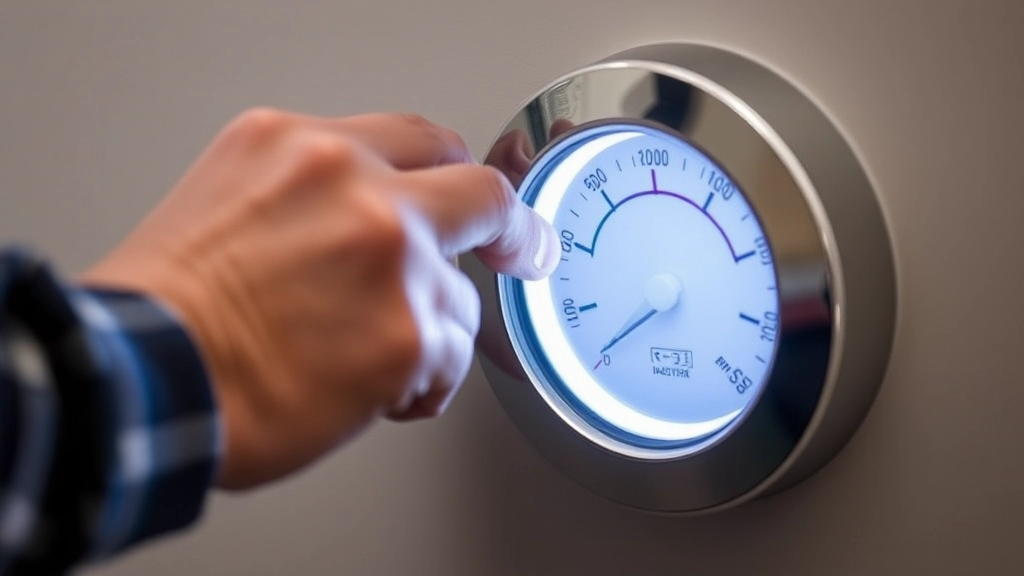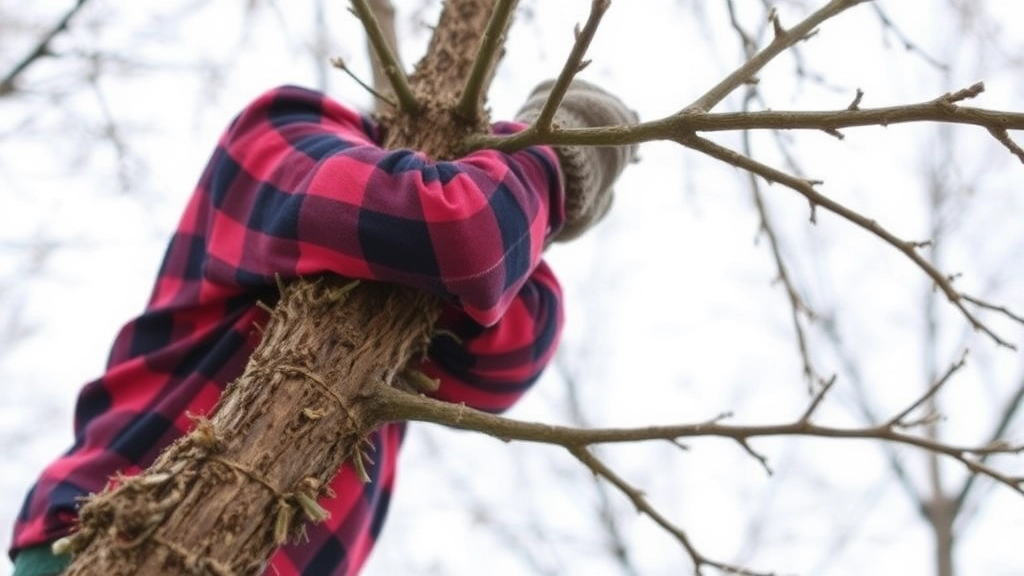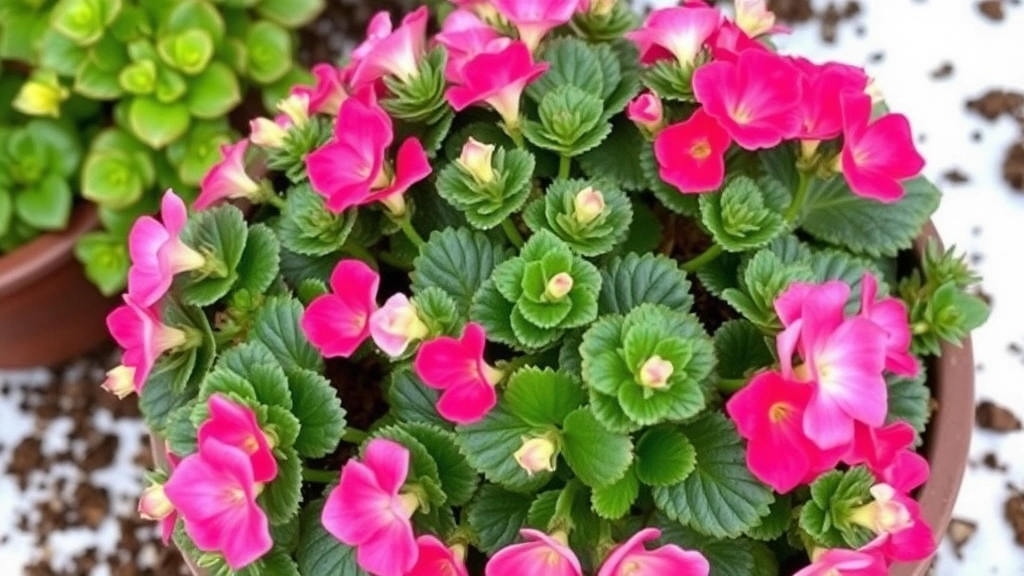Caring for Kalanchoe in Winter
Winter can be tough on kalanchoe plants, but with the right care, they can thrive even in the cold months. As someone who loves gardening, I’ve learned that preparing kalanchoe for winter dormancy is crucial. This involves gradually reducing water and ensuring the plant is in a cooler, but not freezing, environment. Proper light and temperature adjustments are key to keeping your kalanchoe healthy through winter.
Key Considerations
- Watering: Watering schedules need to be adapted; overwatering can lead to root rot, especially in winter.
- Pruning: Pruning before the cold sets in helps the plant conserve energy.
- Frost Protection: If your kalanchoe is outdoors, protecting it from frost is essential.
- Indoor Care: For indoor care, placing the plant near a sunny window can provide the necessary light.
With these tips, you’ll know exactly how to care for kalanchoe in winter and keep your plant happy and healthy.
As the winter months approach, many plant owners find themselves asking, “How can I best prepare my Kalanchoe for dormancy?” This is a common concern, and understanding the right steps can ensure your plant thrives when spring arrives.
Kalanchoe, a resilient succulent, requires specific care to transition smoothly into its dormant phase. This preparation is crucial for its health and longevity. Here’s how to effectively prepare your Kalanchoe for winter dormancy:
– **Assess the Environment:**
– Ensure your Kalanchoe is in a location where it can receive adequate light, even during shorter days.
– A south-facing window is often ideal.
– **Temperature Control:**
– Kalanchoe prefers temperatures between 15°C to 20°C (59°F to 68°F).
– Avoid exposing it to drafts or sudden temperature fluctuations.
– **Reduce Feeding:**
– Stop fertilising your Kalanchoe about a month before winter.
– This allows the plant to conserve energy instead of focusing on new growth.
– **Monitor for Pests:**
– Check your plant regularly for signs of pests, such as mealybugs or aphids.
– Address any infestations promptly to prevent further damage.
By taking these steps, you can ensure your Kalanchoe enters dormancy in the best possible condition. For more detailed tips on caring for your Kalanchoe, you might find the [ultimate care guide for Panda Plant Kalanchoe Tomentosa](https://planthq.org/panda-plant-kalanchoe-tomentosa-ultimate-care-guide/) helpful. Additionally, understanding [why your Kalanchoe leaves might turn red](https://planthq.org/why-kalanchoe-leaves-turn-red-causes-and-solutions/) can provide further insights into maintaining your plant’s health during the winter months.
Adjusting Light and Temperature Requirements

As we prepare our Kalanchoe for winter dormancy, one of the biggest concerns is how to adjust its light and temperature needs.
You might be wondering, “How much light does my Kalanchoe really need in winter?”
Well, here’s the scoop:
- Reduced Daylight: During winter, days are shorter. Kalanchoe thrives on bright, indirect light.
- Location Matters: Place your plant near a south-facing window where it can soak up those precious rays.
- Supplemental Lighting: If natural light is scarce, consider using grow lights. They can really boost your plant’s energy levels.
Now, let’s talk temperature.
- Ideal Range: Kalanchoe prefers a cozy spot between 15°C to 20°C (59°F to 68°F).
- Avoid Cold Drafts: Keep it away from chilly windows or doors. A sudden drop in temperature can stress your plant.
If you notice your Kalanchoe stretching towards the light, it’s a sign it’s not getting enough.
Remember, it’s all about creating a comfortable environment for your plant to rest during dormancy.
Watering Kalanchoe During Winter
As we transition into winter, many plant enthusiasts worry about how to care for their Kalanchoe.
Understanding Water Needs
Kalanchoe, being a succulent, has unique watering requirements, especially during its dormant phase in winter. Overwatering can lead to root rot, a common issue that can devastate your plant.
Key Watering Tips:
- Frequency: Water less frequently in winter. Typically, every 2-3 weeks is sufficient.
- Soil Check: Always check the soil moisture before watering. Stick your finger about an inch into the soil; if it feels dry, it’s time to water.
- Watering Technique: Water thoroughly until it drains from the bottom of the pot, ensuring the roots receive adequate moisture.
- Humidity Considerations: Indoor heating can dry out the air, so monitor humidity levels. If the air is too dry, consider misting the plant lightly or using a humidity tray.
Signs of Overwatering:
- Yellowing leaves
- Mushy stems
- A foul smell from the soil
By paying attention to these signs, you can adjust your watering routine to keep your Kalanchoe healthy throughout the winter. For more detailed advice, you can check out these essential Kalanchoe care tips and learn about the causes and solutions for red leaves on Kalanchoe.
Pruning and Maintenance Before Winter

As we prepare Kalanchoe for its winter dormancy, one crucial step is pruning and maintenance.
Many plant enthusiasts worry about how to keep their Kalanchoe healthy through the colder months.
Why Prune Before Winter?
Pruning not only helps maintain the plant’s shape but also encourages new growth in the spring.
Here are some key reasons to consider:
- Remove Dead or Yellowing Leaves: This prevents disease and encourages healthy growth.
- Shape the Plant: Trim back any leggy or overgrown stems for a more compact appearance.
- Encourage Air Circulation: Thinning out dense areas can prevent mould and pests.
How to Prune Your Kalanchoe
- Use Clean, Sharp Tools: This reduces the risk of infection.
- Cut Just Above a Leaf Node: This encourages new growth from that point.
- Limit Pruning to 20-30% of the Plant: Over-pruning can stress the plant.
Maintenance Tips
- Check for Pests: Inspect your Kalanchoe for signs of pests like aphids or mealybugs.
- Clean the Leaves: Wipe them down with a damp cloth to remove dust and improve photosynthesis.
- Repot if Necessary: If the plant is root-bound, consider repotting it in a slightly larger container with fresh soil.
Preventing Frost Damage in Outdoor Kalanchoe
As we transition into winter, protecting outdoor Kalanchoe from frost becomes a pressing concern.
Why Worry About Frost?
Frost can severely damage Kalanchoe leaves, leading to wilting and even plant death. As a gardener, I understand the anxiety that comes with the cold months. Here’s how to keep your Kalanchoe safe:
- Choose the Right Location:
- Sheltered Spots: Plant your Kalanchoe in areas that are shielded from harsh winds and direct exposure to frost.
- Raised Beds: If possible, elevate your plants. Frost settles in low areas, so a raised bed can provide some protection.
- Use Mulch:
- Apply a thick layer of organic mulch around the base of your Kalanchoe. This helps insulate the roots and retain soil warmth.
- Straw, wood chips, or shredded leaves work well.
- Covering Plants:
- On particularly cold nights, use frost cloths or old blankets to cover your Kalanchoe.
- Ensure the cover reaches the ground to trap heat but avoid direct contact with the leaves to prevent moisture build-up.
- Watering Wisely:
- Water your Kalanchoe a day before a frost is expected. Moist soil retains heat better than dry soil, providing extra protection.
- Bring Potted Kalanchoe Indoors:
- If your Kalanchoe is in a pot, consider bringing it inside during extreme cold spells.
- A garage or unheated room can be a temporary refuge.
By employing these strategies, you can significantly reduce the risk of frost damage to your Kalanchoe. For more detailed advice, check out our ultimate guide to caring for Kalanchoe succulents and learn about the care tips for maximizing the longevity of your Kalanchoe plants.
Indoor Care Tips for Winter Months
As we dive into winter, you might be wondering how to keep your Kalanchoe thriving indoors.
Light Levels Matter
Kalanchoe loves bright light, but winter can be tricky.
- Positioning: Place your plant near a south-facing window for maximum sunlight.
- Rotate: Give it a gentle twist every week to ensure even growth.
Temperature Control
Keeping your Kalanchoe cozy is key.
- Ideal Range: Aim for temperatures between 15°C to 21°C.
- Avoid Drafts: Steer clear of chilly spots near doors and windows.
Watering Wisely
Less is more during winter.
- Check the Soil: Only water when the top inch feels dry.
- Drainage: Make sure your pot has good drainage to prevent root rot.
Humidity Check
Winter air can be dry.
- Misting: A light misting can help, but don’t overdo it.
- Pebble Trays: Placing a tray of water with pebbles under the pot can boost humidity.
Fertiliser Needs
Your Kalanchoe doesn’t need much food in winter.
- Cut Back: Hold off on fertilising until spring.
- Organic Options: When you do feed, consider a diluted liquid fertiliser.
Pest Patrol
Keep an eye out for unwanted visitors.
FAQs on How to Care For Kalanchoe In Winter
What kind of light does my Kalanchoe need during winter?
Kalanchoe thrives on bright, indirect light. During the shorter winter days, place your plant near a south-facing window to maximize light exposure. If natural light is insufficient, consider using grow lights to boost your plant’s energy levels.
What is the ideal temperature range for Kalanchoe in winter?
Kalanchoe prefers a temperature range of 15°C to 20°C (59°F to 68°F). It’s important to keep the plant away from cold drafts, such as those from windows or doors, as sudden drops in temperature can stress the plant.
Why is pruning important before winter dormancy?
Pruning helps maintain the plant’s shape and encourages new growth in the spring. It also removes dead or yellowing leaves, which can prevent disease and encourage healthy growth. Additionally, pruning helps improve air circulation, preventing mould and pests.
How should I prune my Kalanchoe?
When pruning your Kalanchoe, use clean, sharp tools to reduce the risk of infection. Cut just above a leaf node to encourage new growth from that point. Limit pruning to 20-30% of the plant to avoid stressing it.
What maintenance steps should I take before winter?
Before winter, inspect your Kalanchoe for pests such as aphids or mealybugs. Clean the leaves with a damp cloth to remove dust and improve photosynthesis. If the plant is root-bound, consider repotting it in a slightly larger container with fresh soil.
How can I tell if my Kalanchoe is not getting enough light?
If your Kalanchoe is stretching towards the light, it’s a sign that it’s not getting enough light. Adjust its position to ensure it receives adequate bright, indirect light throughout the day.
References
-
How to Adjust Light Requirements for Kalanchoe in Winter
-
Optimal Temperature for Kalanchoe During Dormancy
-
Pruning and Maintenance Tips for Kalanchoe Before Winter
